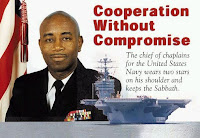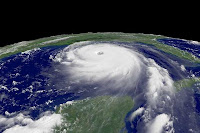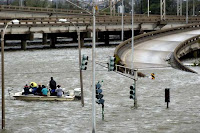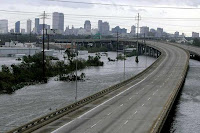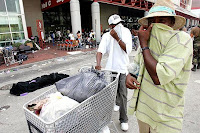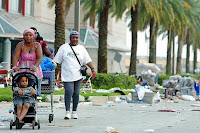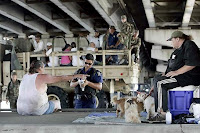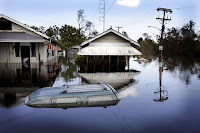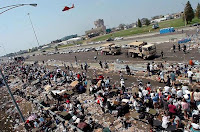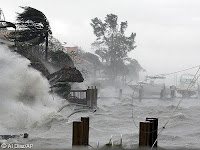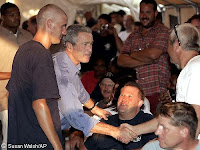
Soldiers Face Neglect and Frustration.
Behind the door of Army Spec. Jeremy Duncan's room, part of the wall is torn and hangs in the air, weighted down with black mold. When the wounded combat engineer stands in his shower and looks up, he can see the bathtub on the floor above through a rotted hole. The entire building, constructed between the world wars, often smells like greasy carry-out. Signs of neglect are everywhere: mouse droppings, belly-up cockroaches, stained carpets, cheap mattresses.
This is the world of Building 18, not the kind of place where Duncan expected to recover when he was evacuated to Walter Reed Army Medical Center from Iraq last February with a broken neck and a shredded left ear, nearly dead from blood loss. But the old lodge, just outside the gates of the hospital and five miles up the road from the White House, has housed hundreds of maimed soldiers recuperating from injuries suffered in the wars in Iraq and Afghanistan.
The common perception of Walter Reed is of a surgical hospital that shines as the crown jewel of military medicine. But 5 1/2 years of sustained combat have transformed the venerable 113-acre institution into something else entirely -- a holding ground for physically and psychologically damaged outpatients. Almost 700 of them -- the majority soldiers, with some Marines -- have been released from hospital beds but still need treatment or are awaiting bureaucratic decisions before being discharged or returned to active duty.
They suffer from brain injuries, severed arms and legs, organ and back damage, and various degrees of post-traumatic stress. Their legions have grown so exponentially -- they outnumber hospital patients at Walter Reed 17 to 1 -- that they take up every available bed on post and spill into dozens of nearby hotels and apartments leased by the Army. The average stay is 10 months, but some have been stuck there for as long as two years.
Not all of the quarters are as bleak as Duncan's, but the despair of Building 18 symbolizes a larger problem in Walter Reed's treatment of the wounded, according to dozens of soldiers, family members, veterans aid groups, and current and former Walter Reed staff members interviewed by two Washington Post reporters, who spent more than four months visiting the outpatient world without the knowledge or permission of Walter Reed officials. Many agreed to be quoted by name; others said they feared Army retribution if they complained publicly.
While the hospital is a place of scrubbed-down order and daily miracles, with medical advances saving more soldiers than ever, the outpatients in the Other Walter Reed encounter a messy bureaucratic battlefield nearly as chaotic as the real battlefields they faced overseas.
On the worst days, soldiers say they feel like they are living a chapter of "Catch-22." The wounded manage other wounded. Soldiers dealing with psychological disorders of their own have been put in charge of others at risk of suicide.
This world is invisible to outsiders. Walter Reed occasionally showcases the heroism of these wounded soldiers and emphasizes that all is well under the circumstances. President Bush, former defense secretary Donald H. Rumsfeld and members of Congress have promised the best care during their regular visits to the hospital's spit-polished amputee unit, Ward 57.
Along with the government promises, the American public, determined not to repeat the divisive Vietnam experience, has embraced the soldiers even as the war grows more controversial at home. Walter Reed is awash in the generosity of volunteers, businesses and celebrities who donate money, plane tickets, telephone cards and steak dinners.
The Pentagon has announced plans to close Walter Reed by 2011, but that hasn't stopped the flow of casualties. Three times a week, school buses painted white and fitted with stretchers and blackened windows stream down Georgia Avenue. Sirens blaring, they deliver soldiers groggy from a pain-relief cocktail at the end of their long trip from Iraq via Landstuhl Regional Medical Center in Germany and Andrews Air Force Base.
One amputee, a senior enlisted man who asked not to be identified because he is back on active duty, said he received orders to report to a base in Germany as he sat drooling in his wheelchair in a haze of medication at Walter Reed. "I went to Medhold many times in my wheelchair to fix it, but no one there could help me," he said.
Finally, his wife met an aide to then-Deputy Defense Secretary Paul D. Wolfowitz, who got the erroneous paperwork corrected with one phone call. When the aide called with the news, he told the soldier, "They don't even know you exist."
"They didn't know who I was or where I was," the soldier said. "And I was in contact with my platoon sergeant every day."

Army Surgeon General Kevin C. Kiley abruptly stepped down under pressure from military superiors, the third top Army official forced out in the fallout from revelations of shabby treatment of wounded soldiers at Walter Reed Army Medical Center.
The Army said Monday, March 12, that Lt. Gen. Kiley had submitted a request to retire over the weekend. Acting Army Secretary Pete Geren had asked Kiley for his retirement, said a senior defense official, speaking on condition of anonymity because he was not authorized to talk about the events.
Kiley's removal underscored how the controversy, which began with reports of dilapidated outpatient housing and a nightmarish bureaucracy at the Army's flagship hospital, has snowballed into a far broader problem for the Bush administration.
Kiley, 56, who headed Walter Reed from 2002 to 2004, has been a lightning rod for criticism over conditions there and has been a frequent target of hostile questions at congressional hearings.
Geren has had his position for less than two weeks, having replaced Army Secretary Francis Harvey, who was dismissed March 2. Maj. Gen. George W. Weightman, who had been in charge of Walter Reed since August 2006, was ousted from his post the day before.
In a statement released by the Army, Kiley said, "I submitted my retirement because I think it is in the best interest of the Army." He said he wanted to allow officials to "focus completely on the way ahead."
"We have failed to meet our own standards at Walter Reed. For that, I'm both personally and professionally sorry," he said last week.
Maj. Gen. Gale Pollock, current deputy surgeon general, assumed Kiley's job while a permanent replacement is sought. Kiley remains on active duty during the retirement process, which could take up to two months.
Amid the focus on Walter Reed, VA Secretary Nicholson on Monday ordered his department's clinics to provide details about their physical condition by next week to determine if squalid conditions found at Walter Reed exist elsewhere.
"We've made a good start, but much remains to be done," Geren told staff members Monday. "I share in your conviction that we will do whatever it takes to do it right."
Labels: Military Morale.


